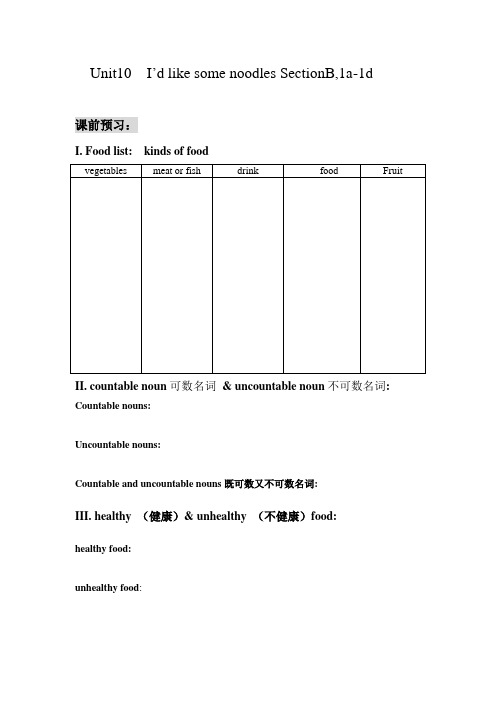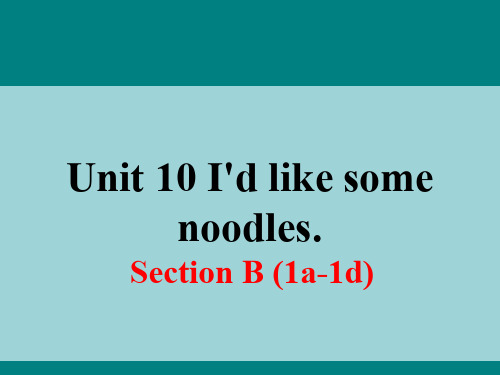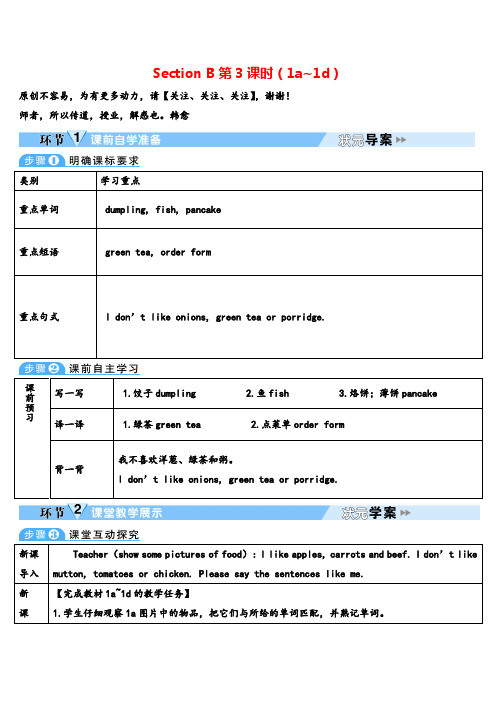2013春七年级(下) Unit 10 Section B 1a-1d
- 格式:ppt
- 大小:3.45 MB
- 文档页数:21

Unit10 I’d like some noodles SectionB,1a-1d课前预习:I. Food list: kinds of foodII. countable noun可数名词& uncountable noun不可数名词: Countable nouns:Uncountable nouns:Countable and uncountable nouns既可数又不可数名词:III. healthy (健康)& unhealthy (不健康)food:healthy food:unhealthy food:课中学习I.Pairwork:编对话说自己对食物的喜好A: What do you like ? B: I like …, … and ….A: What don’t you like?B: I don’t like …, …or…. II.学以致用:I like to eat ___very much. A.fish B.a fish C.fishesTom has five ______at home. A.fish B.fishes C.fishing用and 或or 填空He likes reading __________ playing chess.She isn’t good at singing _________ dancing.Is the camera new __________old?III.根据句意及首字母或汉语提示完成句子1.Most Chinese like ____________ (饺子) very much.2.I often have_____________(粥)for breakfast.3.Would you like some______(茶)?4.Cats like to eat______.5.Apple j______ is a kind of drinks.6.He likes_______ (烙饼) and __________(onion).7.I often buy _________(carrot) in the supermarket.8.Ma Lin likes apples _____eggs for lunchIV、选择题1. She’d ________some beef noodles for lunch.A. likesB. likeC. haveD. has2.I would like tomatoes ________ potatoes.A. andB. withC. orD. but3.---Would you like green tea __ juice?---I don’t like green tea ___ juice.A. and, andB. or, orC. and, orD. or, and.课后反思:收获是__________________________不足是__________________________。


Section B第3课时(1a~1d)原创不容易,为有更多动力,请【关注、关注、关注】,谢谢!师者,所以传道,授业,解惑也。
韩愈类别学习重点重点单词 dumpling, fish, pancake重点短语 green tea, order form重点句式 I don’t like onions, green tea or porridge.课前预习写一写 1.饺子dumpling 2.鱼fish 3.烙饼;薄饼pancake 译一译 1.绿茶green tea 2.点菜单order form背一背我不喜欢洋葱、绿茶和粥。
I don’t like onions, green tea or porridge.新课导入Teacher(show some pictures of food): I like apples, carrots and beef. I don’t like mutton, tomatoes or chicken. Please say the sentences like me.新课【完成教材1a~1d的教学任务】1.学生仔细观察1a图片中的物品,把它们与所给的单词匹配,并熟记单词。
展示新课展示2.学生圈出1a中自己喜欢的食物,在不喜欢的食物旁边打×。
然后让学生两人一组仿照1b来谈论自己喜欢和不喜欢的食物。
教师请几个学生说一说。
3.学生听录音,完成1c的表格。
4.学生再听一遍录音,跟读并订正答案。
【语法提要】oror在此处是并列连词,意为“和”,用于否定句中,代替肯定句中的and。
当句中有两个并列成分时,and/or放在这两个成分中间;当句中有三个或三个以上并列成分时,and/or只用在最后两个成分之间,前面的用逗号隔开。
例句:I don’t like chicken or beef.我不喜欢鸡肉和牛肉。
I like onions, green tea and porridge.我喜欢洋葱、绿茶和粥。



Unit 10 I’d like some noodles.Section B (1a-1d)I.Teaching aims and demands:1. Knowledge objectives:(1) Key vocabularies: dumplings, porridge, green tea, orange juice, soup, onions, fish, pancakes.(2)Students can use target language:①—What would you like?②—I'm not sure yet. Are there any vegetables in the beef noodles?③May I take your order?④—Can we have two bowls of beef soup then?—Sure. What size would you like?—Medium, please.2.Ability objectives:(1)To learn to talk about food preferences.(2)To learn to order foods.(3)To improve students’ listening skills and cooperation ability.3. Emotional objectives(1)Arouse students’ interest in English learning.(2)Enhance students’ confidence by ask and answer questions in English .(3)Help students to form a good eating habit.II.Teaching Key Points:To learn more food names: dumplings, porridge, green tea, orange juice, soup, onions, fish, pancakesIII.Teaching difficult points:To learn to talk about food preferencesTo learn to order foodsIV.Teaching methods:Communicative teaching methodThe Audio-visual teaching methodSituational teaching methodV.Learning methods:Pair-work, self-study learning method, group workVI.Teaching Aids:Multi-media, PowerPointVII.Teaching Procedures:1.Warming-up:Let’s chant and learn some food names2.Lead in: Show a picture and review some food names3.Presentation1). (show some pictures of food on the big screen)Present some new words and expressions to the Ss.2). Ss learn the new words and expressions by themselves and try to remember them.3).Games:To consolidate the the new words and expressions.4). (show some pictures of food on the big screen)Present the important sentence patterns to the Ss.5).Memory game:Let students consolidate the important words and sentence patterns.6).Work on 1a:①.Read the words in the chart and look at the pictures below. Write the letters of the foods or drinks on the line. Then check the answers.②. Let Ss try to remember the new words and expressions.4. Practice:1)Pairwork①.Circle the things you like in 1a. Put an х next to the things you don’t like Then tell you partner what you like and don't like.Sa: I like dumplings, but I don't like noodles.Sb: Well, I like fish but I don't like meat.②.Work in pairs. Talk about what you like and what you don’t like.2) ListeningWork on 1c:1. Ask Ss to read the ORDER FORM carefully.2. Play the tape for the Ss to listen and complete the food order form.(Play the recording for the first time, students write down the answers carefully.Then, listen to the recording again, and check the answers. )Work on 1d:Listen again. Use the pause button to check the answers with the Ss.3)Group workAsk students to work in group. Then give them five minutes to make a conversation to order some food. Ask several groups to show their English menu on the screen and show their conversation.5.Exercise:Translate some important sentences.6.SummaryAsk the students to summarize the key points and the difficult points, then the teacher will supplement.VIII.HomeworkWrite down some sentences about:1.what you like and don’t like.2.what your father/mother likesand doesn’t like.3.what your best friend likesand doesn’t like.Blackboard design:。
成龙学校活页备课纸
英语
学习过程:
一、超前预习
Ⅰ.写出下列单词。
饺子粥,面糊洋葱
鱼,鱼肉烙饼,薄饼
Ⅱ.译出下列短语
绿茶橘子汁
Ⅲ. 试着翻译下面的句子。
1. I ,
2. I ’t ,
3. ’s , ?
.质疑解惑:
和如何使用呢?
二、课中学习
I. 预习检测
. 解决疑惑自主互助学习
知识剖析:
I , . 我喜欢饺子、鱼和橙汁。
I ’t , . 我不喜欢洋葱、绿茶和粥。
(1) 和都用作连词,连接两个并列成分,表示“和”;常用于否定句和疑问句中,两者通常不能互换。
(2)选择疑问句中的并列成分用连接。
例如:, ?
. 学习过程:
I、新课呈现
1 &
2
1a. .
: . : A: 汤. B: .
. 1b.
—I , . — I ’t , .
3
1 1c.
2 . .
4
.
良心做教育实力创未来。